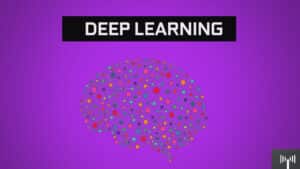Today’s market is fast-paced and competitive, with many industries facing unprecedented demand for growth and sustainable practices. With the obscene amount of data to process and increasing market requirements, it’s becoming difficult for human teams to keep up. Many organizations are realizing the potential of machine learning for overall growth and improving operations to complement the workforce.
The foundation for practical machine learning is laid by the core concepts of evaluating large amounts of data to uncover insightful information. This approach raises the bar of making data-driven decisions by focusing on machine learning’s practical applications. The goal is to create sustainable solutions to improve productivity, efficiency, and decision-making alongside human expertise.
This article will delve into how businesses benefit from using machine learning to solve common problems and highlight prevalent use cases across different industries.
Machine learning and applied machine learning
Traditional programming relies on an explicit chain of instructions that are coded by humans to perform specific actions or solve particular problems in a deterministic manner. In contrast, machine learning models utilize statistical algorithms to learn patterns and relationships in data, and develop a generalized approach to problem-solving.
Theoretical and research-oriented machine learning focuses on developing algorithms that are designed to understand mathematical principles and concepts such as linear algebra, probability, statistics, and optimization techniques for training models. Its primary use case is in the field of academic research where the goal is to advance the theoretical understanding of machine learning and develop new algorithms and techniques that can be applied in practical settings. By emphasizing the underlying mathematical concepts and principles that govern machine learning algorithms, researchers can develop more sophisticated and effective approaches to solving complex problems, with the potential to drive innovations and breakthroughs in different fields.
Traditional machine learning is highly influential in the field, but some criticize it for being overly academic and impractical for real-world issues. On the other hand, applied machine learning focuses on solving practical problems using machine learning techniques, particularly to influence business or industry solutions.
Traditional machine learning has played a foundational role in shaping the field, and applied machine learning builds upon these principles to extract business value with a focus on creating models and deploying them in production environments. This requires a deep understanding of the practical business problem at hand, as well as the ability to extract relevant features from large datasets.
Applied machine learning also involves a range of techniques and tools, such as data preprocessing, feature selection, model selection and tuning, and model deployment. The goal of these techniques is to develop precise and dependable models that help in making informed business decisions. The process may involve:
- Decision Process: During this stage, the algorithm utilizes the available data, which is either labeled or unlabeled, to generate an estimate or pattern.
- Error function: An error function evaluates the prediction of the model to make comparisons and assess the accuracy of the model. It evaluates the difference between the predicted output and the actual output to achieve accuracy.
- Model Optimization: From the data points, the model needs to “fit” by adjusting its internals, therefore, updating weights and parameters autonomously until the accuracy threshold is achieved. Model optimization is an iterative process of adjusting hyperparameters, retraining models with additional data, or using different algorithms.
How machine learning is applied to AI
Artificial intelligence(AI) is a broader field in the domain of computing that encompasses a range of technologies such as speech recognition, natural language processing, computer vision, and more to create machines that can execute tasks and replicate human intelligence in various processes. Machine learning on the other hand is a subfield within AI that involves training models to learn from data and make predictions or decisions based on that learning.
In this case, “learning” is the process in which models utilize algorithms and mathematical functions to map and transform the underlying data that results in accurate predictions. So, while AI is the technology that trains machines to imitate or simulate human intelligence processes in real-world environments, machine learning is the resulting system’s “models” that learn from data to make predictions.
Where does machine learning work?
Manufacturing and automotive industry
Machine Learning in manufacturing is a crucial enabler of efficiency in the manufacturing process, innovation, and even new business opportunities. Machines can learn from various stress points to predict when multiple parts are likely to fail, enabling manufacturers to perform maintenance proactively and reduce downtime. In the automotive industry, predictive maintenance is used to anticipate when a car will require servicing, making it easier for drivers to schedule maintenance appointments and avoid breakdowns. In addition, machine learning is crucial in development of autonomous vehicles that can sense or react to distinct environments in real-time and advanced assistance systems that improve safety and navigation on roads.
Finance sector
Banking and fintech industries utilize machine learning to provide unparalleled insights from vast amounts of financial data, enabling businesses to identify investment opportunities and make informed decisions on trading. Machine learning technology is invaluable in cases like fraud prevention, one of the biggest challenges faced by the industry. By analyzing data, machine learning algorithms can identify clients with high-risk profiles and flag suspicious transactions, helping businesses prevent fraudulent activities. In addition, analyzing cyber surveillance data is crucial in detecting early frauds, maintaining compliance regulations, and enabling institutions to proactively protect themselves and their clients thanks to efficient machine learning techniques.
Healthcare
The healthcare industry is currently experiencing an unprecedented demand for patient care, leading to resource constraints and overwhelming workloads for health practitioners. However, the industry will undergo significant growth and transformation with the emergence of machine learning. The proliferation of data in the digital health landscape provides an opportunity for health practitioners to focus on more pressing needs such as planning treatments and diagnosing ailments. For example, radiologists face a shortage of qualified professionals, leading to challenges in performing computed tomography scans and keeping up with cancer-related issues. Machine learning algorithms can be used to process medical imaging procedures, reducing errors, mitigating human fatigue, and improve the accuracy of cancer diagnoses. This makes machine learning a crucial tool in healthcare, enabling enhanced patient care and allowing practitioners to focus on critical tasks.
Computer vision
Computer vision is a field of AI that focuses on training machines to interpret and process the visual world. Computer vision systems use sensors, cameras, images or even systems to identify and track objects and motions using machine learning models. Facial recognition algorithms can be used to train computers to recognize faces, while object tracking algorithms track movements from objects based on video surveillance footage. Autonomous vehicles use machine learning and object detection capabilities to recognize traffic signals, pedestrians, roadblocks and other cars on the road, which enhances safety.
Robotics
The success and effectiveness of robots in their intended environments rely heavily on their ability to process and analyze large amounts of data and act upon it. Robotics experts rely on machine learning techniques to help robots recognize objects, navigate complex environments seamlessly, and make informed decisions based on sensory inputs in order to improve their ability to perform critical tasks with precision and accuracy.
Energy
Global energy consumption is rapidly increasing as economies expand. It is crucial to identify ways to cut expenses, streamline processes, and minimize the effects on the environment like in the field of oil and gas. By using machine learning, companies in the petroleum industry can discover new sources, optimize drilling and production, and predict the location of reservoirs and minerals. Furthermore, it is crucial to streamline the costly distribution process. By leveraging sensors to study conditions that enhance performance, machine learning becomes an indispensable tool in creating an efficient and digitally-driven energy sector that will ensure the stability of our universe.
Benefits of applied machine learning
- Flexibility and automation: machine learning can help automate complex tasks that would otherwise involve a significant amount of time and resources to complete. For instance, financial systems use machine learning algorithms to detect fraud or identify other patterns in financial data, allowing organizations to take action more quickly and efficiently and reduce human error.
- Seamless analysis at scale: In the age of big data, machine learning is a critical piece of technology in automating analytical model building and workflows. However, managing data collection, storage, and processing with feature engineering demands constant collaboration and resources. So, how can we provide a fast and scalable way to improve model efficiency while cutting down resource needs and promoting collaboration? This is where feature stores come in. So, what is a feature store? It is a central place for building, scaling, and accessing feature data. The model development is a streamlined process that scales with automation pipelines while further reducing costs and making more accurate predictions.
- Better risk management: Businesses can identify potential risks, such as fraudulent transactions or cybersecurity threats allowing them to take proactive measures to mitigate those risks. By utilizing machine learning tools, businesses can quickly identify unusual insights in large amounts of data, allowing them to identify potential risks and take preventive actions before they become significant problems.
- Enhanced customer experience: The end goal of business is to satisfy the customer. Applied machine learning ensures that brands offer personalized customer experiences and tailored recommendations. Businesses can build predictive models that identify customer behavior and preferences, enabling them to deliver highly personalized experiences that build customer loyalty and drive revenue growth.
When applying machine learning in real-world scenarios, challenges arise that are not present in traditional academic settings. It is therefore crucial to be aware of challenges that affect thousands or even millions of people when machine learning techniques are applied to solve business needs. These issues and legal considerations include the following:
- Need for high-quality data: Machine learning algorithms are complex. Low-quality datasets skew the results but unlike in academic settings, obtaining enough data is more difficult and more so, expensive to buy datasets. Sometimes only huge organizations can afford to push the technology to the edge.
- Maintenance: Machine learning models suffer from decay as times change and data obtained from the real world no longer reflects the data used to train the models. To keep up with maintenance, businesses need to have more than just data scientists but a whole cross-functional team that understands business plans, the subject matter, ethics and laws, and more.
- Data protection and privacy: Using personal information comes with compliance laws around the collection, use, processing, security, and retention across different the world. For example, health applications powered by machine learning need to use imaging, diagnostics, and surgery results that need a high level of privacy and informed consent.
- Bias and discrimination: Machine learning models rely on data to make decisions and predictions and the algorithm is only as good as the data it is trained on. With the possibility that data used is generated by humans, it may contain a level of business that leads to a degraded business outcome. To improve on this, businesses need to pay attention to the data they collect and conduct regular assessments by sampling, cleaning, and diversifying the dataset to remove irrelevant to shape the business outcome.
Conclusion
Applied machine learning is reshaping the world order. As industries continue to execute projects based on machine learning as the core of automation and business functions, their abilities in driving business value cannot be understated.
In the digital age, machine learning is a great boon in communicating and controlling machines with neuro-interfaces. From smart home systems that operate remotely and autonomously to making data-driven business decisions in fields like finance and healthcare, the technology is only getting better and many organizations are incorporating it into their applications to leapfrog competitors and uncover the path toward success.



